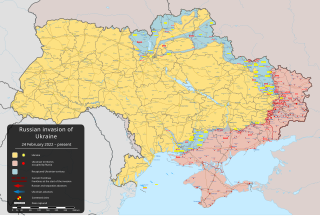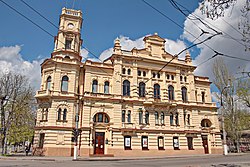
Looting is the act of stealing, or the taking of goods by force, typically in the midst of a military, political, or other social crisis, such as war, natural disasters, or rioting. The proceeds of all these activities can be described as booty, loot, plunder, spoils, or pillage.

The Iraq Museum is the national museum of Iraq, located in Baghdad. It is sometimes informally called the National Museum of Iraq. The Iraq Museum contains precious relics from the Mesopotamian, Abbasid, and Persian civilizations. It was looted during and after the 2003 Invasion of Iraq. Despite international efforts, only some of the stolen artifacts have been returned. After being closed for many years while being refurbished, and rarely open for public viewing, the museum was officially reopened in February 2015.

Art theft, sometimes called artnapping, is the stealing of paintings, sculptures, or other forms of visual art from galleries, museums or other public and private locations. Stolen art is often resold or used by criminals as collateral to secure loans. Only a small percentage of stolen art is recovered—an estimated 10%. Many nations operate police squads to investigate art theft and illegal trade in stolen art and antiquities.

Stéphane Breitwieser is a French art thief and author, notorious for his art thefts between 1995 and 2001. He admitted to stealing 239 artworks and other exhibits from 172 museums while travelling around Europe and working as a waiter, an average of one theft every 15 days. The Guardian called him "arguably the world's most consistent art thief". He has also been called "one of the most prolific and successful art thieves who have ever lived", and "one of the greatest art thieves of all time". His thefts resulted in the destruction of many works of art, destroyed by his family to conceal evidence of his crimes.

Arkhip Ivanovich Kuindzhi or Arkhyp Kuindzhi was a landscape painter of Greek descent from the Russian Empire.

Nazi plunder was organized stealing of art and other items which occurred as a result of the organized looting of European countries during the time of the Nazi Party in Germany.

Repatriation is the return of the cultural property, often referring to ancient or looted art, to their country of origin or former owners.

Looted art has been a consequence of looting during war, natural disaster and riot for centuries. Looting of art, archaeology and other cultural property may be an opportunistic criminal act or may be a more organized case of unlawful or unethical pillage by the victor of a conflict. The term "looted art" reflects bias, and whether particular art has been taken legally or illegally is often the subject of conflicting laws and subjective interpretations of governments and people; use of the term "looted art" in reference to a particular art object implies that the art was taken illegally.
Art theft and looting occurred on a massive scale during World War II. It originated with the policies of the Axis countries, primarily Nazi Germany and Japan, which systematically looted occupied territories. Near the end of the war the Soviet Union, in turn, began looting reclaimed and occupied territories. "The grand scale of looted artwork by the Nazis has resulted in the loss of many pieces being scattered across the world."

Portrait of a Young Man is a painting by Raphael. It is often thought to be a self-portrait. During the Second World War the painting was stolen by the Nazis from Poland. Many historians regard it as the most important painting missing since World War II.

The Reichsleiter Rosenberg Taskforce was a Nazi Party organization dedicated to appropriating cultural property during the Second World War. It was led by the chief ideologue of the Nazi Party, Alfred Rosenberg, from within the NSDAP Office of Foreign Affairs. Between 1940 and 1945, the ERR operated in France, Netherlands, Belgium, Poland, Lithuania, Latvia, Estonia, Greece, Italy, and on the territory of the Soviet Union in the Reichskommissariat Ostland and Reichskommissariat Ukraine. Much of the looted material was recovered by the Allies after the war, and returned to rightful owners, but there remains a substantial part that has been lost or remains with the Allied powers.

The looting of Polish cultural artifacts and industrial infrastructure during World War II was carried out by Nazi Germany and the Soviet Union simultaneously after the invasion of Poland of 1939. A significant portion of Poland's cultural heritage, estimated at about half a million art objects, was plundered by the occupying powers. Catalogued pieces are still occasionally recovered elsewhere in the world and returned to Poland.

"The Spoils of War—World War II and Its Aftermath: The Loss, Reappearance, and Recovery of Cultural Property" was an international symposium held in New York City in 1995 to discuss the artworks, cultural property, and historic sites damaged, lost, and plundered as a result of World War II. The three-day event was sponsored by the Bard Graduate Center for Studies in the Decorative Arts to commemorate the 50th anniversary of the end of the war. The conference was organized by Elizabeth Simpson, an archaeologist and professor at the Bard Graduate Center.

The southern Ukraine campaign is an ongoing theatre of operation in the Russian invasion of Ukraine, which began on 24 February 2022. The Russian military invaded Kherson Oblast in southern Ukraine from Russian-occupied Crimea, quickly entering Mykolaiv Oblast and Zaporizhzhia Oblast amid battles with the Armed Forces of Ukraine.

Hero City of Ukraine is a Ukrainian honorary title awarded for outstanding heroism during the 2022 Russian invasion of Ukraine. It was awarded to ten cities in March 2022, in addition to four already-named Hero Cities of the Soviet Union. This symbolic distinction for a city corresponds to the distinction of Hero of Ukraine awarded to individuals.

Melitopol Museum of Local History is a museum in Melitopol, Ukraine. It exhibits objects relating to the history and nature of the region. The museum is located in the former Chernikov Mansion, built in 1913. As of 2022 its director was Leila Ibragimova.

Russia began an invasion of Ukraine on 24 February 2022, in a major escalation of the Russo-Ukrainian War that began in 2014. It is the largest military attack in Europe since World War II. During the fighting, many pieces of Ukrainian cultural heritage were either destroyed, damaged, or put at risk due to the widespread destruction across the country. This deliberate destruction and looting of over 500 Ukrainian cultural heritage sites is considered a war crime and has been described by Ukraine's Minister of Culture as cultural genocide.

The Kherson Art Museum is an art museum in Kherson, Ukraine. It is housed in Kherson's former city hall building. The museum opened on 27 May 1978.

Since the beginning of the Russian invasion of Ukraine in February 2022, the media have been publishing eyewitness accounts of military operations in Ukraine about cases of looting by soldiers of the Russian army. International organizations such as Human Rights Watch, as well as Ukrainian, European and Russian independent media and NGOs document and investigate cases of looting and transportation of stolen personal items and industrial equipment to the territory of Russia and Belarus.

The Kherson Local History Museum is a cultural institution and museum that was created in 1963 following the merging of the Kherson Historico-Archeological Museum and the Kherson Natural Historical Museum. The Historico-Archeological Museum was founded in 1890 and the Natural Historical Museum was founded in 1899. The museum has a branch in Kakhovka.



















